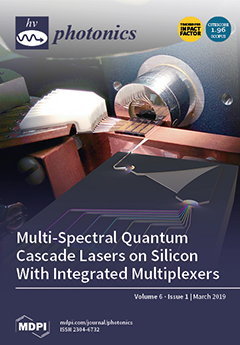Open AccessFeature PaperEditor’s ChoiceArticle
Multi-Spectral Quantum Cascade Lasers on Silicon With Integrated Multiplexers
by
Eric J. Stanton, Alexander Spott, Jon Peters, Michael L. Davenport, Aditya Malik, Nicolas Volet, Junqian Liu, Charles D. Merritt, Igor Vurgaftman, Chul Soo Kim, Jerry R. Meyer and John E. Bowers
Cited by 10 | Viewed by 5103
Abstract
Multi-spectral midwave-infrared (mid-IR) lasers are demonstrated by directly bonding quantum cascade epitaxial gain layers to silicon-on-insulator (SOI) waveguides with arrayed waveguide grating (AWG) multiplexers. Arrays of distributed feedback (DFB) and distributed Bragg-reflection (DBR) quantum cascade lasers (QCLs) emitting at ∼4.7 µm wavelength are
[...] Read more.
Multi-spectral midwave-infrared (mid-IR) lasers are demonstrated by directly bonding quantum cascade epitaxial gain layers to silicon-on-insulator (SOI) waveguides with arrayed waveguide grating (AWG) multiplexers. Arrays of distributed feedback (DFB) and distributed Bragg-reflection (DBR) quantum cascade lasers (QCLs) emitting at ∼4.7 µm wavelength are coupled to AWGs on the same chip. Low-loss spectral beam combining allows for brightness scaling by coupling the light generated by multiple input QCLs into the fundamental mode of a single output waveguide. Promising results are demonstrated and further improvements are in progress. This device can lead to compact and sensitive chemical detection systems using absorption spectroscopy across a broad spectral range in the mid-IR as well as a high-brightness multi-spectral source for power scaling.
Full article
►▼
Show Figures





